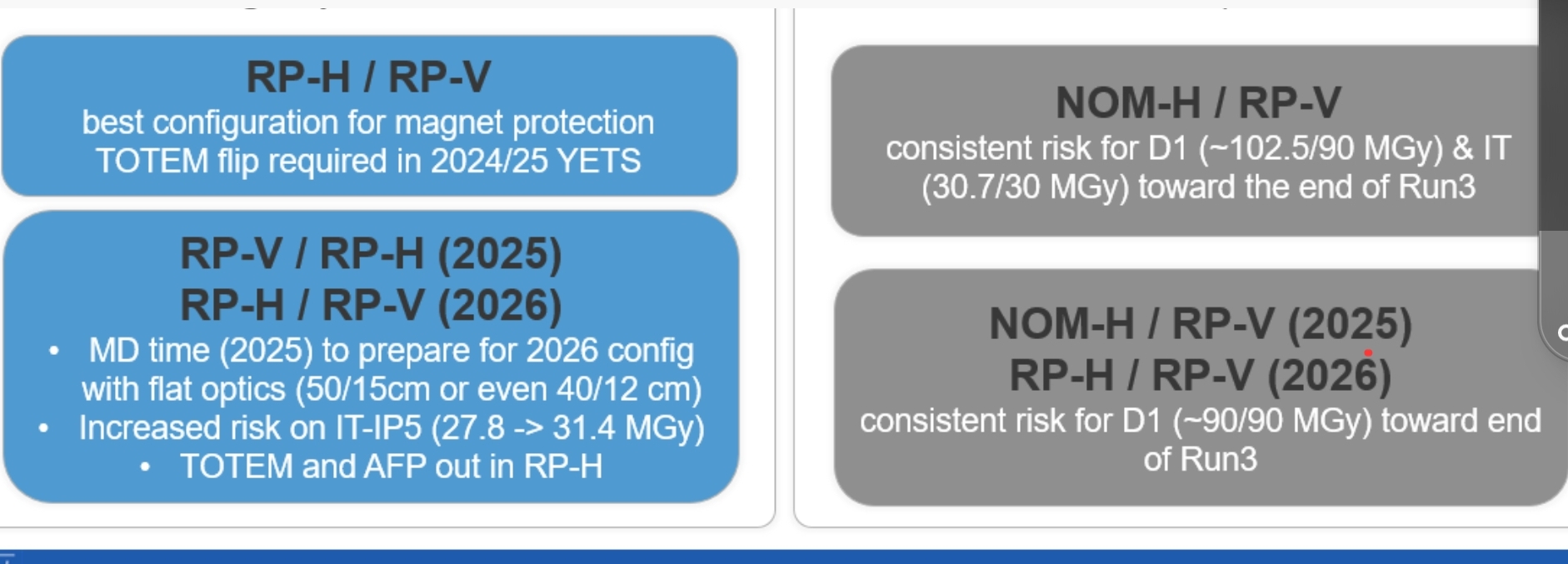LNO section meeting on Impact of D1 b3, HL-LHC MD results and maps for dipoles fringes
LNO section meeting on Impact of D1 b3, HL-LHC MD results and maps for dipoles fringes
News, Rogelio: We had two MD sessions since the last meeting. One HL-LHC MD could not take place.
The LHC 2025 optics configuration and other RF, impedance, high intensity MDs were successful.
There has been good progress in the ion commissioning, including optics corrections performed Thursday to Friday last week.
Tobias commented that challenges were mostly connected to triplet corrections, and that a small beta beating was achieved as end result.
Felix says that LEIR is working well and ready to supply ions when needed.
Concerning LHC optics for the coming years, Rogelio comments on 4 options sketched below, featuring all polarity inversion in IP5 and in most cases also going to flat optics changing the H/V crossing planes. This options will also be discussed in LBOC and LMC.

As a result of the very good LHC performance and as an introduction for the following presentation, Joerg Wenninger comments that the magnets around IP1/5 already collected significant radiation doses, in some regions approaching the estimated lifetime limits. The cold magnet radiation limits are less well known and could be much longer than 30 MGy estimates. For warm magnets, and in particular the first of the six D1 separation dipole pieces, there is a real danger of radiation damage for which we should better be prepared. He says there are also more hardware related options currently under discussion, like changing the most exposed D1 pieces, maybe even in the coming winter stop, or the possibility of continued running in case of partial shorts resulting in a minor reduction of some D1 strengths.
Linear optics corrections in case of failing D1, Joshua Dilly, slides
Joshua studied linear optics implications and corrections in case of loss of one of the six D1 pieces, compensated by an increase of strength of the remaining 5 pieces. He finds that the main effect would be an increase of the b3 component generating 6% beta-beating, which cold be corrected down to 0.4 %. He also find that dispersion and tune changes can well be corrected. He concludes that the linear optics implications of a single D1 piece failure could well be corrected.
Ewen Maclean commented on other optics implications (no slides). The MCSX magnets (that are also subject to high radiation with some danger of failure) can provide crossing angle dependent corrections and are currently powered using 5 - 12 A. In case of a D1 piece failure the currents would be increased to something like 20 A which remains well within the hardware limitations (50 A).
Furthermore there are other options to correct b3 using arc sextupoles, with however typically more unwanted side effects like inducing chromatic beta-beating.
HL-LHC optics MD results, Yannis Angelis, slides
Yannis presents a preliminary analysis of HL-LHC optics MD results, focusing on a single β* (165/84 cm). For beam1 he compares no, old and new corrections using sextupole bumps +MQT in Arcs45,81. Similarly he illustrates β-beating and phase errors for beam2 using old and new Arc45 corrections and illustrates efforts to identify the sources of phase errors. He concludes that the local arc corrections improve the beam1 optics and that further corrections are required for beam2.
Dipoles fringe fields, Silke Van Der Schueren, slides
Silke presents an analytical study of dipole fringe fields and compares their implementation in MAD8/MADX and PTC. As an introduction, she reminds us how the dipole transfer maps can be obtained using the Hamilton formalism and Lie algebraic techniques a la Dragt et al. She describes in more detail the straight bend rectangular hard edge magnet with fringe fields for straight or curved pole faces and the use of a single component b1(s) ~ 1+tanh function to parameterize the smooth field increase at the edges. To first order the fringe field effect can be taken into account as a matrix with two non-trivial elements depending on the pole rotation, in agreement with both MAD and PTC. She observes some differences between implementations for the second order, which correspond to pole face curvatures. In MAD, the second order corrections are introduced by tensor terms. Differences in MAD and PTC appear to originate in requirements for symplecticity. She observes that the PTC symplectic map has an extra cyf3 term that is not described in the documentation. In the discussion after this presentation it was said that this extra term may have been introduced for compatibility with the SAD code. Silke says she plans next to compare the fringe field effects using examples of real magnets and small machines like ELENA where fringe fields can be very significant allowing for benchmarking of codes with measurements.
Laurent proposes to also compare with TPSA techniques and MAD-ND and Rogelio proposes to extend the studies to quadrupole fringe field effects.
